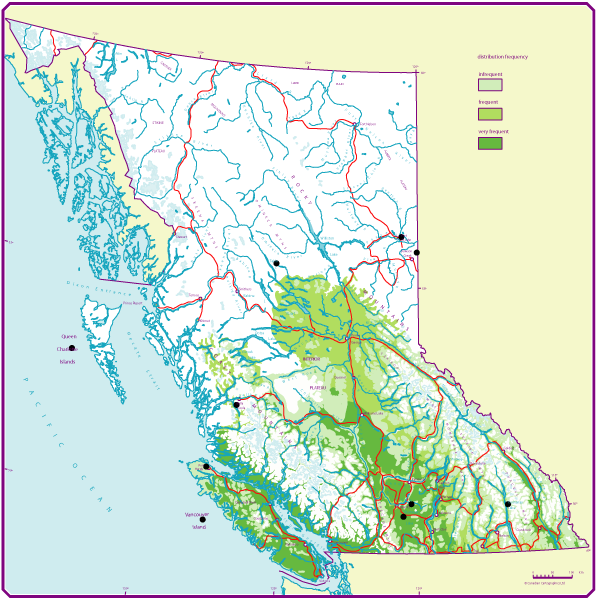Douglas-fir
Douglas-fir (Fd) - Pseudotsuga menziesii
Douglas-fir is a medium- to large-sized (reaching nearly 100m in height), evergreen conifer, and at maturity has a moderately dense, conical crown with long branches, and deeply furrowed, dark reddish-brown bark with irregular, broad ridges.
Common Douglas-fir is one of the most important and valuable timber species of Western North America, as well as many other temperate forest regions in which it has been successfully introduced.
On this page
Geographic range and ecological amplitudes
Geographic range
Geographic element:
Western North American/Pacific and Cordilleran
Distribution in Western North America:
central and south in the Pacific region; central and south in the Cordilleran region
Ecological amplitudes
Climatic amplitude:
(subalpine boreal) - montane boreal - (semiarid) - cool and warm temperate - cool (and warm) mesothermal
Orographic amplitude:
submontane - montane - (subalpine)
Occurrence in biogeoclimatic zones:
(lower southern MH), (lower southern ESSF), MS, southern SBS, (SBPS), (BG), (PP), IDF, southern ICH, CDF, southern CWH
Edaphic amplitude

Range of soil moisture regimes:
very dry - moderately dry - slightly dry - fresh - moist - very moist
Range of soil nutrient regimes:
(very poor) - poor - medium - rich - very rich
It has been experimentally found that common Douglas-fir grows poorly where it is dependent only on NH4-N for its nitrogen supply, but grows best in soils that are rich in NO3-N (Garm 1958, Krajina 1969). Nitrate-poor soils are indicated by Mor humus formation and the presence of oxylophytic plants, while nitrate-rich soils are indicated by Moder and Mull humus formation and the presence of nitrophytic plants (nitrate accumulators) which have easily detectable nitrates, especially in their leaves: Such as
- Sambucus racemosa L.
- Rubus spectabilis Pursh
- R. parviflorus Nutt.
- Ribes bracteosum Dougl. ex. Hook.
- R. lacustre (Pers.) Poir, Adenocaulon bicolor Hook.
- Asarum caudatum Lindl.
- Athyrium filix-femina (L.) Roth
- Bromus vulgaris (Hook.) Shear
- Cardamine breweri S. Wats.
- Carex deweyana Schwein.
- C. hendersonii Bailey
- Cinna latifolia (Trev. ex. Goepp.) Griseb
- Claytonia sibirica (L.)
- Dicentra formosa (Andr.) Walp.
- Galium triflorum Michx.
- Geum macrophyllum Willd.
- Melica subulata (Griseb.) Scribn.
- Mitella ovalis Greene
- Oenanthe sarmentosa K. Presl ex. DC.
- Osmorhiza chilensis Hook. & Arn.
- Stachys cooleyae Heller
- S. mexicana
- Stellaria crispa Cham. & Schlecht.
- Tellima grandiflora (Pursh) Dougl. ex. Lindl.
- Tiarella laciniata Hook.
- T. trifoliata L.
- Tolmiea menziesii (Pursh) Torr. and Gray
- and Urtica dioica (L.)
However, in addition to nitrates, some ammonium compounds are beneficial for common douglas as they are necessary for phosphorus to be in soluble form.
Calcium deficiency is manifested in calcium-dieback of roots. However, common douglas may survive more easily than other species because it can develop new roots when older ones die.
Tolerances and damaging agents
Root system characteristics
Common Douglas-fir is a deep-rooting species; however, as in many other tree species, its root morphology varies according to the nature of the soil. In deep, well-drained soils, taproots may grow up to 50% of their final depth in 3 to 5 years. Plate-like root systems develop when it grows in shallow soils or with a high water table. Fine roots are concentrated in the upper 20 cm of soil. Roots of common douglas are associated with both ecto- and endo-mycorrhizae.
| Tolerance to | Tolerance class | Comments |
|---|---|---|
| low light | L - H | protection-requiring in dry climates, exposure-requiring in humid climates |
| frost | L - M | low in coastal populations, intermediate in interior populations |
| heat | M - H | intermediate in coastal populations, high in interior populations; protection-requiring on warm and dry sites |
| water deficit | M | protection-requiring on dry and warm sites |
| water surplus | L | intolerant of flooding and strongly fluctuating water table |
| nutrient (mainly N) deficiency | M | infrequent on very poor sites |
| Tolerance to | Tolerance class | Comments |
|---|---|---|
| low light | L - H | protection-requiring in dry climates, exposure-requiring in humid climates |
| frost | L - M | low in coastal populations, intermediate in interior populations |
| heat | M - H | intermediate in coastal populations, high in interior populations; protection-requiring on warm and dry sites |
| water deficit | M | protection-requiring on dry and warm sites |
| water surplus | L | intolerant of flooding and strongly fluctuating water table |
| nutrient (mainly N) deficiency | M | infrequent on very poor sites |
| Damaging agent | Resistance class | Comments |
|---|---|---|
| snow | L - M | low in coastal populations, intermediate in interior populations |
| wind | H | n well-drained soils |
| risk class | ||
|---|---|---|
| fire | M - H | resistant to ground fires when mature; susceptible to crown fires |
| insects | H | a major concern in interior populations; western spruce budworm; Douglas-fir tussock moth |
| fungi | H | root and butt rots (for example, red ring rot, Armillaria root disease) are a major and increasing concern; Douglas-fir needle cast not a serious concern |
| other agents | L | dwarf mistletoe (Arceuthobium douglasii Engelmann); browsing and clipping by rabbits, hares, pocket gophers, mountain beavers, and deer |
Associated tree species and successional role
In British Columbia, common douglas grows in pure even-aged (usually after wildfires), uneven-aged stands, or in a great variety of mixed-species stands. It is often a pioneer species (primary succession) on colluvial sites, and is present in early, mid-, and late stages of secondary succession. It is a major or minor component in old-growth forests in boreal, cool temperate, and cool mesothermal climates.
| Associated tree species |
Occurance class | Major area of occurance |
|---|---|---|
| western hemlock | H | one of the most common associates in CWH and ICH |
| western redcedar | H | one of the most common associates throughout the native range of common douglas |
| trembling aspen | M | central and southern B.C |
| ponderosa pine | M | Southern B.C |
| lodgepole pine | M | throughout the native range of common douglas |
| western larch | M | throughout the native range of western larch |
| white spruce (and hybrids) | L | mainly in southern SBS |
| engelmann spruce | L | lower central and southern ESSF |
| paper birch | L | throughout the native range of common douglas |
| bigleaf maple | L | CDF and southern drier CWH |
| subalpine fir | L | MS, southern SBS, and southern ICH |
| grand fir | L | southern ICH and CDF |
| pacific silver fir | L | southern montane CWH |
Genetics and notes
Genetic
Common Douglas-fir has two widely recognized varieties: menziesii, the green or coastal variety, and glauca, the blue or interior variety. Intravariety breeding is fairly frequent but not easily detectable morphologically. The interior variety grows more slowly than the coastal variety, both in the interior and along the coast; but the coastal variety does not survive or grows poorly in cool temperate climates.
Common douglas has one of the broadest latitudinal range of any North American conifer. Thus clinal patterns of variation in growth and phenological traits have been observed over latitudinal, as well as longitudinal, and elevational transects.
Notes
Common Douglas-fir is a very productive and desirable species considering its easy regeneration and good growth which remains fairly constant for a long time. More detailed silvics information is given by:
Hermann, R.K. and D.P. Lavender. 1990. Pseudotsuga menziesii. Pp. 527-540 in R.M. Burns and B.H. Honkala (technical coordinators) Silvics of North America, Vol. 1. Agri. Handbook 654, USDA For. Serv., Washington, D.C.
Oliver, C.D., D.P. Hanley, and J.A. Johnson. (editors) 1986. Douglas-fir: Stand management for the future. Institute of Forest Resources, Contribution No. 55, University of Washington, Seattle, Washington. 388 pp.



